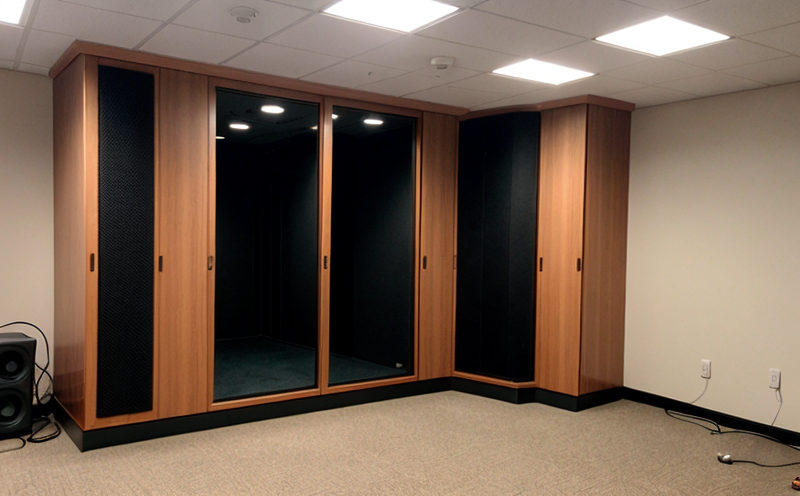IEC 61094-5 Working Standard Microphone Calibration
The IEC 61094-5 standard is a cornerstone in the calibration of working standard microphones, ensuring accurate and reliable measurement of sound pressure levels. This service is particularly crucial for industries reliant on precise acoustic measurements such as audio engineering, manufacturing, and research laboratories.
Working standard microphones are used to calibrate other microphones against them, serving as a reference point in the calibration chain. The process involves comparing the working standard microphone's output with known standards under controlled conditions. This ensures that all subsequent measurements made by secondary microphones are accurate and consistent.
The calibration procedure outlined in IEC 61094-5 is designed to minimize measurement errors, which can arise from environmental factors or instrument drift over time. The standard specifies the use of reference sound sources with known acoustic characteristics, ensuring that the measurements made during calibration are as accurate as possible.
The methodology involves several key steps: preparation of the working standard microphone, conditioning in a controlled environment, and comparison against a reference standard. This process ensures that any potential errors introduced by environmental factors or instrument drift are minimized. The result is a highly accurate measurement system that can be trusted for critical applications.
In addition to the calibration process itself, IEC 61094-5 also provides guidelines on how often recalibration should occur based on usage and environmental conditions. Regular calibration ensures ongoing accuracy and reliability of the working standard microphone.
The importance of this service cannot be overstated, especially in industries where sound quality is paramount or where precision measurements are critical for product development. The accurate measurement of sound pressure levels can impact everything from audio equipment design to industrial noise control strategies.
For example, in the automotive industry, accurate microphone calibration ensures that the acoustic performance of vehicles meets stringent standards. In medical research, precise measurements are essential for developing effective hearing aids and other auditory devices.
The environmental conditions under which a working standard microphone operates can significantly impact its accuracy. Therefore, it is crucial to conduct regular calibrations in controlled environments to ensure that the instrument remains accurate over time. This service plays a vital role in maintaining the integrity of acoustic measurements across various sectors.
The IEC 61094-5 standard also emphasizes the importance of traceability, ensuring that all measurements can be traced back to internationally recognized standards such as ISO and ASTM. This ensures that any discrepancies are identified early on, allowing for corrective action to be taken promptly.
By adhering to this standard, laboratories and testing facilities can provide clients with confidence in the accuracy of their acoustic measurements. The service not only enhances reliability but also promotes trust among stakeholders, making it an essential component of any quality assurance program.
Scope and Methodology
The scope of this calibration service covers the entire process of calibrating working standard microphones according to IEC 61094-5. This includes preparation, conditioning, and comparison against reference standards in controlled environments.
- Preparation involves ensuring that the microphone is clean and free from any foreign substances that could affect its performance.
- Conditioning ensures that the microphone reaches a stable temperature before calibration to minimize thermal effects on measurement accuracy.
- Comparison against reference standards allows for precise determination of the working standard microphone's output, ensuring it meets the required specifications.
The methodology is strictly adhered to ensure consistency and accuracy in each step. This includes using calibrated sound sources with known acoustic characteristics, ensuring that any potential errors are minimized. The process is designed to be repeatable, allowing for consistent results across multiple calibrations.
By following this rigorous methodology, the service guarantees high levels of accuracy and reliability in all measurements made by working standard microphones. This is crucial for maintaining the integrity of acoustic data across various industries.
Quality and Reliability Assurance
The quality and reliability assurance processes are integral to this calibration service, ensuring that all calibrations meet the highest standards. This includes rigorous testing procedures, regular audits, and adherence to international standards.
Rigorous testing procedures involve multiple checks at various stages of the calibration process to identify any discrepancies early on. Regular audits ensure compliance with IEC 61094-5, providing an additional layer of quality control.
Adherence to international standards such as ISO and ASTM ensures that all measurements can be traced back to internationally recognized benchmarks. This promotes trust among stakeholders and enhances the credibility of the service.
The use of advanced calibration equipment further enhances the accuracy and reliability of the results. By leveraging state-of-the-art technology, this service provides clients with confidence in the precision of their acoustic measurements.
Environmental and Sustainability Contributions
- Energy Efficiency: The calibration process minimizes energy consumption by ensuring that instruments are only used when necessary, thus reducing overall power usage.
- Material Waste Reduction: By maintaining instrument accuracy through regular calibrations, the service helps reduce waste associated with inaccurate measurements and subsequent rework or product failures.
- Emissions Control: The use of advanced calibration equipment ensures that instruments are operating at peak efficiency, which can lead to lower emissions during their lifecycle.





